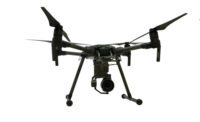Drones are attracting a lot of interest for their ability to help construction managers track changes, quantify production and plan logistics. But they also are exciting construction photographers who appreciate their ability to easily send cameras to vantage points that previously were accessible only through elaborate—and, often, very expensive— means.
|
Click here to view ENR's 2015 Photo Contest: Jobsite Geometry |
Professional and amateur photographers from coast to coast are experimenting with drones-and-camera combinations and are dreaming up new things to try.
“Obviously, it gives you access to almost any angle you are trying to reach,” says Rehema Trimiew, a freelance videographer and photographer in New York City who even has experimented with shooting from a drone flying inside underground excavations. “Sadly, underground, the GPS is lost, so it’s difficult to keep the quadcopter stable. It starts to drift around,” she says.
Trimiew, who has two winning photos in this year’s gallery (see pp. 26 and 35), recently took a DJ1 Inspire drone in her camera kit for a shoot in West Africa. She found it gave her an angle on her work that would not have been possible before (see photo, above). Now, she wants to try setting up a drone to record a project’s evolution over time, she says.
“I use it for video, in addition to photography, and I was hoping to do moving time-lapse work, where you program in GPS coordinates and then re-video and photograph the same coordinates every month. At the beginning, it’s empty, and, by the end of the video, you have a finished shot of a completed project [that] has transitioned through several phases of construction. I could envision it looking really amazing,” she says.
Amazing is becoming the norm, says Sam Darghous, lead drone pilot and trainer at Pittsburgh-based Michael Baker International. He says drones and drone photography will become jobsite standards.
In the past, there were only two options for jobsite photography: up-close shots—taken by hand, usually from the ground—and wide-angle shots, taken from high above a site in a helicopter or airplane, says Darghous. Unmanned aerial vehicles (UAVs) add a perspective that can be up close and personal, yet airborne. “Everyone is getting used to seeing that level of detail now, that artistic type of photography,” he says. “Drones might not become requirements for jobs soon, but the photos only drones can get will be.”
And the new aerial capability comes with a big cost break.
“For construction photography, UAVs are awesome. We’re getting shots that were previously impossible,” says Ryan Swakon, a licensed pilot and photographer for Precision Unmanned Aerial in Fort Lauderdale, Fla. “Before, you’d have to spend thousands of dollars an hour to get an image. Now, it’s almost painless.” He says he uses UAVs to shoot in places that even helicopters can’t go.
“We’re shooting the Seattle Space Needle, and we can’t be under it with a helicopter. With a UAV, we can, and we also can go through parking structures or under bridges,” says Swakon. However, he warns would-be drone photographers to be aware of the legal differences between shooting on foot and in the air.
“Not just anyone can put a camera on a UAV,” Swakon says. Current Federal Aviation Administration regulations require commercial drone photographers to be licensed aircraft pilots and obtain an FAA 333 exemption. They also cannot fly higher than 400 ft or near airports, heliports and manned aircraft, says Swakon.
And new regulations also require that every drone, whether flown by a hobbyist or a professional, be registered with the FAA. But working within the regulations is worth it, says Swakon. “We’re going to do crane inspections, and we’re taking pictures of the cotter pins themselves in very high quality,” he says.
Safety is another reason for switching to drones. One of this year’s photo-contest winners, Kevin Shea, says he crawls and climbs all over jobsites. But he is considering getting a drone and a new camera, if only for his peace of mind, because climbing while carrying camera equipment can be risky.
“Any camera should be tethered to you securely when climbing. That weight, dropped, would be serious—as in the [construction supervisor] saying ‘Leave the site now’ serious,” says Shea. “I’ve been up over 500 ft on a crane.”
There’s a new little Sony camera that shoots 4K images using strait glass—a prime lens. Now that drone camera technology has advanced beyond the fish-eye GoPro cameras, he says he won’t have to sacrifice quality for convenience.
Few drone-operating photographers see themselves as artists. Like Darghous, most see drones and cameras as data-gathering tools.
“I don’t consider myself a photographer only. I’m a pilot, a photographer, a surveyor and an engineer,” says Darghous. “On any given day, I’ll need to be any one of those.”





Post a comment to this article
Report Abusive Comment